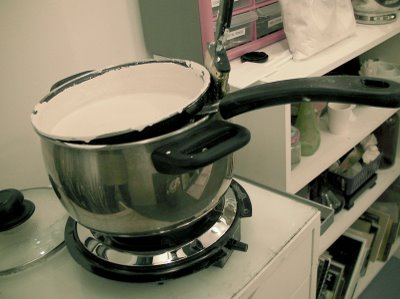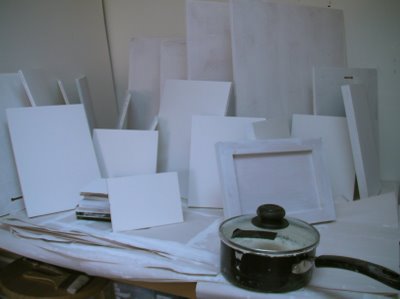I've finally decided it's time to bite the bullet and become a painter who preps my own supports.
"Support" is the general term for what an oil painting is painted onto, either a wooden panel or stretched canvas. I prefer wood panels to stretched canvas because the surface is smoother and more rigid.
Previously I have mainly used factory-gessoed wood panels, like GessoBoard. Gesso is the chalky white paint that is layered on a canvas or wood panel before you start an oil painting. But I've decided that if I'm going to spend 60 hours on a painting, I may as well spend a couple hours preparing the surface.
So being an all-or-nothing type, I dove in and spent 3 solid days layering 19 panels with 2 layers of rabbit skin glue and 5-6 coats of homemade gesso, sanding between each layer. My right deltoid muscle aches to say the least.
I used traditional gesso materials from Sinopia (glue crystals, chalk, and white pigment) and combined them using their traditional gesso recipe. For the wood panels I used ArtBoards of all sizes, rectangles and squares from 6 x 6 inches up to 18 x 24 inches.
 I bought a single burner hotplate for using in my studio, and improvised a double boiler by nesting two old cooking pots together - two pots that won't ever be used for food again.
I bought a single burner hotplate for using in my studio, and improvised a double boiler by nesting two old cooking pots together - two pots that won't ever be used for food again.
First I soaked the rabbit skin glue crystals in water overnight, which made a transparent, gelatenous gray lumpy mixture. Then I put the mixture into my double boiler, and when it warmed up it got clearer, runnier, and became a thin, watery glue. It spread really easily onto my wood panels with a housepainting brush, but immediately began to sink in to the wood and dried almost instantly.
Re-reading the directions, I found out I had to do TWO coats of the glue. It wasn't too horrible, and I have a good ventilation system in my studio, but there was definitely a distinctly funky odor. I don't know exactly how they make rabbit skin glue, but I imagine vegetarian painters don't use it.
Once the panels were sealed with the glue, I mixed together the chalk, white pigment, and remaining glue mixture and warmed it to make the gesso. It made a watery, not very paint-like liquid, so I had to play around with the proportions a bit. But I found it works best if it's slightly more watery than housepaint, so you can paint thin layers.
 This was how I stacked them to dry, "good side" leaning down to avoid dust, but careful not to let the front surface touch anything. I got pretty good at perfecting a sort stable mutual leaning system. Every time I added a layer of gesso to a panel, I had to lean it up to dry, and by the time the last was painted the first was ready to be sanded, so I had to rotate them around quite a bit.
This was how I stacked them to dry, "good side" leaning down to avoid dust, but careful not to let the front surface touch anything. I got pretty good at perfecting a sort stable mutual leaning system. Every time I added a layer of gesso to a panel, I had to lean it up to dry, and by the time the last was painted the first was ready to be sanded, so I had to rotate them around quite a bit.
The sanding was the most tedious part, and my arm began to really ache. The second and third day I tried to use my left hand as much as my right to sand, so now both my arm ache.
Anyway, the project was a success - I now have 19 beautiful panels with a silky/chalky/smooth surface, plus a dozen teeny tiny panels that were just laying around the studio, for little oil sketches. Hopefully I won't have to do this again for a long time!
